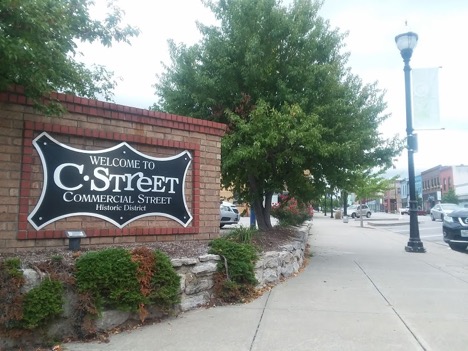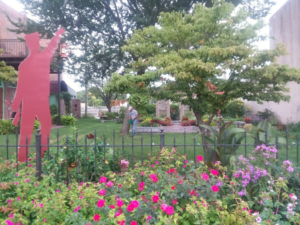
C-Street quickly proving it’s the place to be
Community, Front Page, Lifestyle, Weekend September 28, 2018, Comments Off 131As one of Springfield’s fastest-growing areas, Commercial Street has seen an enormous resurgence of business, culture and community. Behind the booming growth is a community of entrepreneurs and business owners looking to make “C-Street” the place to be in Springfield.
A product of the railroad
Commercial Street sprang into being in 1870, before Springfield’s city limits even reached so far north. Its beginning was a result of the arrival of the Atlantic and Pacific Railroad, the first railroad to run through the Springfield area. A commercial district catering to rail workers immediately began to thrive, giving the strip along the rail line its now iconic name.
“Springfield and Joplin were competing to have the depot in their city and had Springfield not gotten the trains, not gotten the first depot, which was at Benton and Commercial…” said the Commercial Club’s president, Mary Collette. “The trains are what brought manufacturing, goods…and people into Springfield.”
In 1887, the district became part of the city limits and many businesses moved north following the economic boom brought by rail workers. Commercial Street peaked in the late 1950s with thriving businesses that existed completely independent of the railroad industry, including furniture stores, a paint company and a drugstore.

Courtesy of historiccstreet.com.
The early 1960s, however, saw a population shift back toward the south side of town and a sharp decline in railroad travel. Businesses began to fail as people moved away, and property values plummeted. Many impoverished families moved north. Commercial Street saw a spike in its homeless population, leading to the foundation of several soup kitchens and homeless shelters like The Kitchen and the Missouri Hotel in the 1970s.
The area was designated a local historic district in 1978 by the Commercial Club and added to the National Register of Historic Places in 1983.
The smallest town in Springfield
The C-Street of today prides itself on the diversity of businesses in its community. There are many shops, maker spaces and housing options, as well as fashion and second-hand stores. The street also has a variety of barbers, stylists and tattoo studios. One of the biggest things C-Street is known for, however, is a large number of international dining choices.
Elie and Elizabeth Ghane opened their Middle Eastern restaurant, called That Lebanese Place, in 2013 on Commercial Street, following the success of their food truck.
“We were a little apprehensive at first,” Elizabeth Ghane said. “People from C-Street came to the food truck and invited us to look at the area. Our first thought was ‘Commercial Street? Really?’”
Joe Gidman, owner of Cafe Cusco, Van Gogh’s Eeterie and Chabom Tea & Spices was also hesitant when considering C-Street as a location to open his business.
“A friend of mine had pushed for me to check out this building on Commercial Street, and at that point, Commercial Street was not a place you wanted to open a restaurant,” Gidman said. “[My mom and I] went over to Big Momma’s and sat there for about an hour, just watching people come in and interact with the [staff]. And we just realized that there were people there who just seemed like friendly, loyal, neighborhood people. They were of a professional age… And definitely had expendable income. And so that’s why we took that chance and decided to come up here, for the people.”
There is a strong sense of community among the business owners of Commercial Street.
“I would say that C-Street is the smallest town in Springfield,” said Gidman. “Everyone knows everyone’s business.”
Elizabeth Ghane agreed, saying that there is not a great deal of competition on Commercial Street.
“There’s only one Lebanese place, only one Peruvian place, only one Dutch,” she said. “The closest thing to competitors are the sandwich shops like Big Momma’s or Sisters in Thyme, and even they have their own unique things to offer that set them apart.”
If anything, Ghane said, the businesses help each other by attracting foot traffic.
“People will pass by, and they’re going to see your restaurant [or] shop even if they aren’t going to your place. So, they’ll know to come back,” she said. “We all draw people here in our own ways.”

Photo via Forest Swisher.
Drury has propelled Commercial Street
College students are becoming a bigger part of the culture of Commercial Street, according to Gidman.
“Our biggest supporters starting out were the old-timers who remembered C-Street back in its heyday,” Gidman said. “It wasn’t until about two years ago that we began to be seen as sort of this trendy place to be.”
Faculty and administration at Drury were extremely supportive of the growth of Commercial Street, Gidman stated. Professors and administrators visited restaurants and shops on Commercial Street and booked catering from Commercial Street restaurants, providing valuable exposure for those businesses.
“Drury helped us more so than any other college nearby,” Gidman said. “More than OTC, more than MSU, more than Evangel. It was Drury who really did our advertising for us.”
Students who are interested in keeping up to date with all the happenings of Commercial Street can subscribe to their bi-monthly newsletter, The Communique.
“It has the events that are going on right now, and different things going on the shops, sales and stuff,” said Collette.
The future of C-Street: Gentrification?
Both Gidman and Ghane are optimistic about what the future holds for Commercial Street.
“I expect C-Street to just keep growing and expanding in general,” Ghane said. “More shops, more restaurants. I’d like to see fewer people have our initial reaction, to not think ‘Really?’ I’d like to see more people come to expect goodness and culture from C-Street.”
“When we first started, there was so much of convincing people that it was, in fact, safe,” Gidman said. “I’ve never had an issue; I’ve never not felt safe here. I don’t hear that so much anymore.”
According to Gidman, the biggest issue facing Commercial Street now is maintaining its momentum. “Everyone wants to know what’s new up here, and it’s a small district, so there can only be so many new things at once,” he said. “Since C-Street is a bubble separated from the rest of the city, it gets easily forgotten.”
Gidman is optimistic about Commercial Street’s ability to keep moving forward, saying that he expects a surge in residential buildings such as apartment complexes in the area. Gidman stated confidently that Commercial Street will become less of an island and more seamlessly connected to Downtown and more of Springfield in general.

Photo via Forest Swisher.
Despite this optimism, Gidman is aware of the issues that arise with this kind of growth.
“I do think that the area is definitely going to gentrify,” Gidman said. “That does cause a lot of tension in different demographics, and there will be people who are going to feel pushed out.”
Gentrification occurs when low-income households are displaced by rising property values, something that many in the Midtown area are weary of. There is little being done by the Commercial Street community to combat this. According to Gidman, there is little that can be done at all.
“The commercial value of a place is based on what it can rent for, so in order for the values to increase the rents have to increase and that is what provides value to a space. That value is what attracts better businesses,” Gidman said. “It’s a double-edged sword.”
If gentrification happens too quickly, Gidman said, people get displaced. If the property values rise at a slower, controlled rate, then people have the opportunity to get better jobs and increase their standing.
Ghane was more optimistic about Commercial Street’s effect on surrounding communities.
“There are more Middle Eastern families in the area than many people are aware of,” Ghane said, “and after That Lebanese Place opened they finally had a place to say, ‘This is ours, this is what we have to offer.’ That Lebanese Place has brought cultures together, and, whatever else may come out of C-Street in general, I think that we have many more opportunities to do that again. Whether it be among different [social classes] of people or different cultures, C-Street brings people together, and that’s really what North Springfield needs.”
Written by Forest Swisher and Afton Jagels.